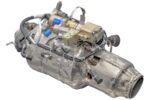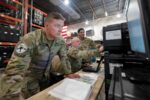The U.S. Department of Defense has awarded a $995 million contract to Amentum Services Inc. to provide comprehensive support for the U.S. Air Force’s MQ-9 Reaper unmanned aerial vehicle (UAV) fleet through 2030. The award underscores the enduring importance of the MQ-9 in U.S. intelligence, surveillance and reconnaissance (ISR) and precision strike operations worldwide.
Scope of the Contract: Global Sustainment for a Global Asset
The indefinite-delivery/indefinite-quantity (IDIQ) contract—managed by the Air Force Life Cycle Management Center (AFLCMC), Wright-Patterson Air Force Base—covers contractor logistics support (CLS), maintenance, supply chain management, and field service representative (FSR) deployment across all active MQ-9 operating locations globally.
Work will be performed at multiple sites including:
- Creech Air Force Base (Nevada)
- Holloman AFB (New Mexico)
- March Air Reserve Base (California)
- Various overseas locations where MQ-9s are deployed
The contract runs through October 31, 2030. According to DoD contracting data, initial funding of $36 million from fiscal year 2024 operations and maintenance funds was obligated at award.
Amentum’s Role and Legacy in UAV Sustainment
Amentum is no newcomer to military aviation logistics or unmanned systems sustainment. The company—formed from legacy businesses including DynCorp International and portions of AECOM—has long provided aviation MRO services across multiple platforms for the U.S. military.
Its involvement with the MQ-9 program includes both stateside and deployed support roles since at least the mid-2010s. The new award consolidates various sustainment functions under one umbrella contractor as the USAF moves toward more centralized lifecycle management strategies for high-demand platforms like the Reaper.
The MQ-9 Reaper: Backbone of U.S. Armed ISR Operations
The General Atomics Aeronautical Systems Inc. (GA-ASI) MQ-9 Reaper is a medium-altitude long-endurance (MALE) remotely piloted aircraft system capable of both ISR and precision strike missions. Introduced in the mid-2000s as a successor to the MQ-1 Predator, it has become a cornerstone of U.S. counterterrorism and battlefield surveillance operations over two decades.
Key specifications include:
- Wingspan: ~20 meters
- Endurance: Up to ~27 hours depending on payload
- Cruise speed: ~370 km/h
- Payload capacity: Over 1,700 kg including AGM-114 Hellfire missiles, GBU-series bombs
- Sensors: EO/IR turret with laser designator; Lynx SAR/GMTI radar; SIGINT pods on some variants
- Control system: Ground Control Station via Ku-band SATCOM or LOS datalink
The platform remains in high demand not only by USAF but also by allied operators including France, Italy, UK, Netherlands, Spain and others under Foreign Military Sales programs.
Sustainment Challenges Amid High Operational Tempo
The global footprint of MQ-9 operations—from CENTCOM theaters like Iraq/Syria/Afghanistan to AFRICOM missions in Niger or EUCOM ISR flights over Eastern Europe—places immense strain on logistics chains and airframe availability rates.
Sustainment contracts like this one are critical to ensuring high mission-capable rates despite aging airframes and harsh environmental conditions at forward-deployed locations. This includes:
- Depot-level maintenance cycles
- Spares provisioning for engines (Honeywell TPE331), sensors & weapons pylons
- Software updates & ground station integration support
A key focus area is also cybersecurity hardening across control systems—a growing concern as adversaries improve electronic warfare capabilities targeting UAV C2 links.
Manning Shifts as Automation Expands
This CLS contract also reflects evolving manpower models within USAF UAV squadrons. While pilots still operate from Ground Control Stations stateside or in-theater hubs like Al-Udeid AB or Ramstein AB under distributed operations concepts, much of the platform-level maintenance is now outsourced to contractors like Amentum.
This allows uniformed personnel to focus on mission execution while industry partners handle sustainment pipelines—a model increasingly common across other platforms such as RQ-4 Global Hawk or even manned ISR aircraft like RC-135 Rivet Joint under similar CLS frameworks.
Future Outlook for MQ-9 Fleet Modernization
This award comes amid ongoing discussions about future force structure changes within USAF’s ISR enterprise post-Afghanistan drawdown and amid great power competition shifts toward Indo-Pacific scenarios where contested airspace may limit MALE UAV survivability.
The service continues investing in upgrades such as:
- M-code GPS receivers & anti-jam antennas
- Lynx Block XX radar enhancements with maritime modes
- Open mission systems architecture integration
- AIRBORNE BLOS comms redundancy improvements via SATCOM/LTE hybrid links
A parallel effort—the “MQ Next” program—is exploring stealthier Group V successors with higher survivability against near-peer IADS threats such as China’s HQ-series SAMs or Russia’s S‑400/S‑500 systems.
Conclusion: Sustaining a Workhorse While Preparing for What’s Next
Amentum’s nearly billion-dollar contract ensures that one of America’s most relied-upon unmanned platforms remains combat-ready well into the next decade—even as strategic priorities shift toward peer conflict readiness rather than counterinsurgency alone.
This deal reflects not just logistical necessity but also doctrinal continuity—the recognition that persistent airborne ISR paired with precision strike capability remains foundational across all domains of modern warfare.









